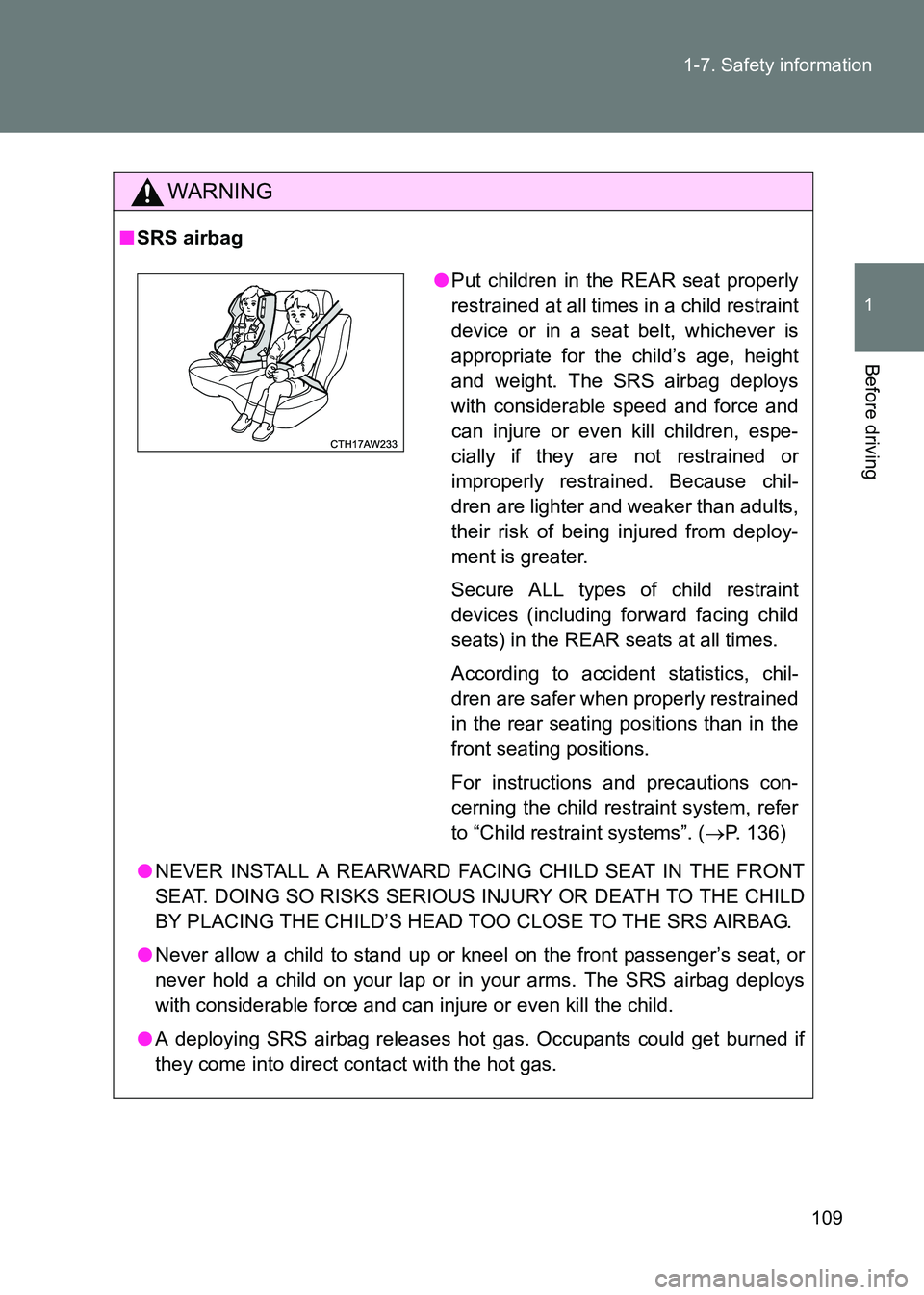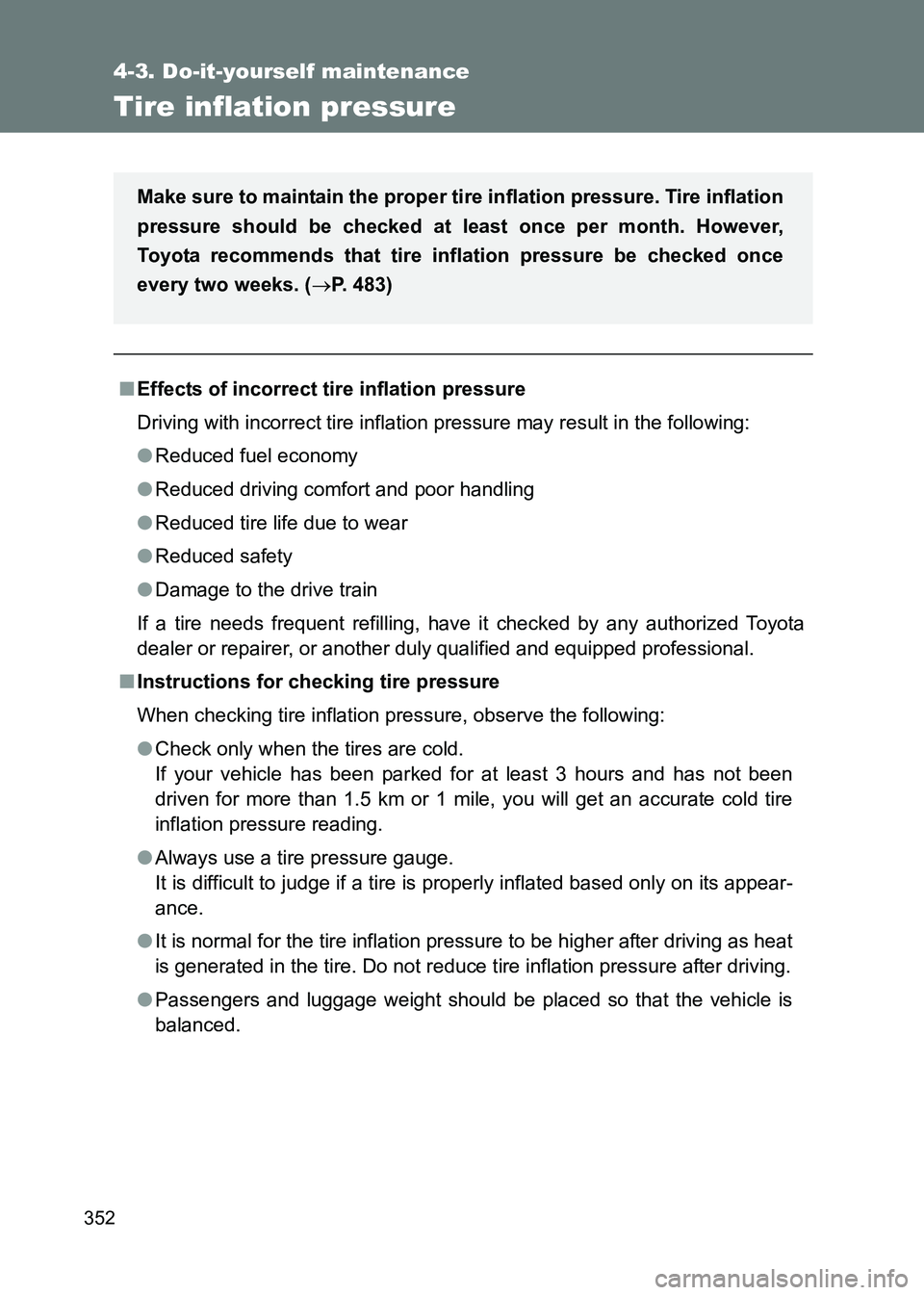Page 64 of 505
64
1-2. Opening, closing and locking the doors and trunk
86_EE (OM18071E)
WARNING
●
Do not attach any accessories other than genuine Toyota parts to the trunk
lid. Such additional weight on the tr unk lid may cause the lid to suddenly
shut again after it is opened.
■ Trunk lid damper stays
Do not pull on or disassemble the trunk lid damper stays, or dispose of them
in a fire. Illustrations on the trunk lid damper stays indicate the following:
●When closing the trunk lid, observe
the following precautions:
• Take extra care to prevent your
fingers etc. from being caught.
Vehicles without a rear spoiler
• Make sure to press the trunk lid lightly on its outer surface.
Vehicles with a rear spoiler
• Do not place your hand(s) between the rear spoiler and trunk
lid when closing the trunk lid.
• To close the trunk lid, press the rear spoiler on either of the por-
tions .
: Do not pull
: Do not disassemble
: Do not dispose of in fire
Page 109 of 505

109
1-7. Safety information
1
Before driving
86_EE (OM18071E)
WARNING
■
SRS airbag
●NEVER INSTALL A REARWARD FACING CHILD SEAT IN THE FRONT
SEAT. DOING SO RISKS SERIOUS INJURY OR DEATH TO THE CHILD
BY PLACING THE CHILD’S HEAD TOO CLOSE TO THE SRS AIRBAG.
● Never allow a child to stand up or kneel on the front passenger’s seat, or
never hold a child on your lap or in your arms. The SRS airbag deploys
with considerable force and can injure or even kill the child.
● A deploying SRS airbag releases hot gas. Occupants could get burned if
they come into direct contact with the hot gas.
● Put children in the REAR seat properly
restrained at all times in a child restraint
device or in a seat belt, whichever is
appropriate for the child’s age, height
and weight. The SRS airbag deploys
with considerable speed and force and
can injure or even kill children, espe-
cially if they are not restrained or
improperly restrained. Because chil-
dren are lighter and weaker than adults,
their risk of being injured from deploy-
ment is greater.
Secure ALL types of child restraint
devices (including forward facing child
seats) in the REAR seats at all times.
According to accident statistics, chil-
dren are safer when properly restrained
in the rear seating positions than in the
front seating positions.
For instructions and precautions con-
cerning the child restraint system, refer
to “Child restraint systems”. ( →P. 136)
Page 257 of 505
257
2
When driving
86_EE (OM18071E)
2-5. Driving information
Cargo and luggage
WARNING
■Things that must not be carried in the trunk
The following things may cause a fire if loaded in the trunk:
●Receptacles containing gasoline
● Aerosol cans
Take notice of the following information about storage precautions,
cargo capacity and load:
● Stow cargo and luggage in the trunk whenever possible.
● Be sure all items are secured in place.
● To maintain vehicle balance while driving, position luggage
evenly within the luggage compartment.
● For better fuel economy, do not carry unnecessary weight.
Page 325 of 505
325
4-3. Do-it-yourself maintenance
4
Maintenance and care
86_EE (OM18071E)
WARNING
■
Pre-driving check
Check that the hood is fully closed and locked.
If the hood is not locked properly it may open while the vehicle is in motion
and cause an accident, which may result in death or serious injury.
NOTICE
■When opening the hood
●Do not lift up or operate the wipers. Doing so may cause the hood and wip-
ers to contact, scratching the hood.
● Use caution when opening the engine hood in windy weather as it may
close suddenly in strong wind.
● Do not attach any accessories other than genuine Toyota products to the
engine hood. Such additional weight on the engine hood may cause it to
be too heavy to be supported by the supporting rod when opened.
■ When closing the hood
Do not apply excessive weight or force when closing the hood as doing so
may result in damage.
Page 352 of 505

352
4-3. Do-it-yourself maintenance
86_EE (OM18071E)
Tire inflation pressure
■Effects of incorrect tire inflation pressure
Driving with incorrect tire inflation pressure may result in the following:
● Reduced fuel economy
● Reduced driving comfort and poor handling
● Reduced tire life due to wear
● Reduced safety
● Damage to the drive train
If a tire needs frequent refilling, have it checked by any authorized Toyota
dealer or repairer, or another duly qualified and equipped professional.
■ Instructions for checking tire pressure
When checking tire inflation pressure, observe the following:
●Check only when the tires are cold.
If your vehicle has been parked for at least 3 hours and has not been
driven for more than 1.5 km or 1 mile, you will get an accurate cold tire
inflation pressure reading.
● Always use a tire pressure gauge.
It is difficult to judge if a tire is properly inflated based only on its appear-
ance.
● It is normal for the tire inflation pressure to be higher after driving as heat
is generated in the tire. Do not reduce tire inflation pressure after driving.
● Passengers and luggage weight should be placed so that the vehicle is
balanced.
Make sure to maintain the proper ti
re inflation pressure. Tire inflation
pressure should be checked at least once per month. However,
Toyota recommends that tire inflation pressure be checked once
every two weeks. ( →P. 483)
Page 354 of 505

354
4-3. Do-it-yourself maintenance
86_EE (OM18071E)
Wheels
If a wheel is bent, cracked or heavily corroded, it should be replaced.
Otherwise, the tire may separate from the wheel or cause loss of
handling control.
■ Wheel selection
When replacing wheels, care should be taken to ensure that
they are equivalent to those removed in load capacity, diameter,
rim width, and inset
*.
Replacement wheels are available at any authorized Toyota
dealer or repairer, or another duly qualified and equipped profes-
sional.
*: Conventionally referred to as “offset”.
Toyota does not recommend using:
● Wheels of different sizes or types
● Used wheels
● Bent wheels that have been straightened
■ Aluminum wheel precautions
●Use only Toyota wheel nuts and wrenches designed for use
with your aluminum wheels.
● When rotating, repairing or changing your tires, check that the
wheel nuts are still tight after driving 1600 km (1000 miles).
● Be careful not to damage the aluminum wheels when using
tire chains.
● Use only Toyota genuine balance weights or equivalent and a
plastic or rubber hammer when balancing your wheels.
Page 472 of 505
472
86_EE (OM18071E)
6-1. Specifications
Maintenance data (fuel, oil level, etc.)
Dimensions and weight
*: Unladen vehicle
Overall length 4240 mm (166.9 in.)
Overall width 1775 mm (69.9 in.)
Overall height*1320 mm (52.0 in.)
Wheelbase 2570 mm (101.2 in.)
TreadFront 1520 mm (59.8 in.)
Rear 1540 mm (60.6 in.)
Gross vehicle massDetails are described on the manufac-
turer’s label. (
→P. 473)
Maximum permissi-
ble axle capacityFront 876 kg (1931 lb.)
Rear 943 kg (2079 lb.)